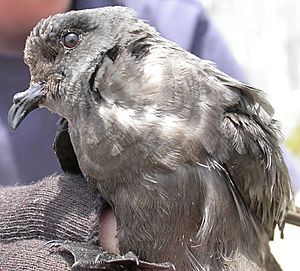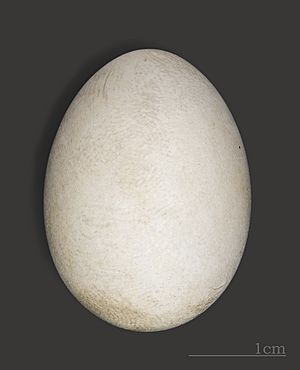Ashy storm petrel facts for kids
Quick facts for kids Ashy storm petrel |
|
|---|---|
 |
|
| Conservation status | |
| Scientific classification | |
| Genus: |
Oceanodroma
|
| Species: |
homochroa
|
 |
|
| Synonyms | |
|
|
The ashy storm petrel (Oceanodroma homochroa) is a small, rare seabird. It belongs to the storm petrel family. These birds nest in groups on islands. These islands are found off the coasts of California and Mexico. The ashy storm petrel is one of six storm petrel types. They live and feed in the rich California Current system.
Contents
About Its Name
The ashy storm petrel was first described in 1864. An American bird expert named Elliott Coues gave it its name. Both its common name "ashy" and its scientific name homochroa mean "uniformly colored." This comes from Ancient Greek words. They describe its plain, single color.
What It Looks Like and How It Lives
This storm petrel is small. It is a plain sooty-brown color. It has a forked tail. It looks a lot like the black storm petrel. However, the ashy storm petrel is smaller. It also flies differently. Its wings flutter more. The upstroke of its wings only goes level with its body. Other storm petrels in its area lift their wings higher.
What They Eat
Ashy storm petrels like to be in groups at sea. They hunt for food at night. They eat cephalopods like squid. They also eat fish, especially deep-sea lanternfish. These fish come closer to the surface at night. They also eat tiny krill, which are small shrimp-like creatures. Krill also gather at the surface. Sometimes, these birds will follow fishing boats. They eat the fish oils that spill when nets are pulled up.
Nesting and Family Life
Ashy storm petrels nest in rock burrows. They choose islands far from the mainland. They return to their nests at night. Their breeding cycle is quite long. They lay eggs in May. The young birds are ready to fly by October. However, the timing can vary a lot. Some pairs might have a half-grown chick. Other pairs might still be laying eggs.
Like many seabirds, these birds are loyal. They stay with the same mate for many years. They also use the same nesting burrow. This is true even though they spend the non-breeding season apart. Many birds might seem to compete for burrows. But these pairs stick to their chosen spot. If a pair changes mates, they usually change their nesting site too.
How Long They Live
The ashy storm petrel lives a long time. One bird that was banded was found to be at least 31 years old.
Where They Live and Why They Need Help
Ashy storm petrels breed on 17 islands. These islands are in the northeast Pacific. Most are off the coast of California. A few are off the coast of northwestern Mexico. About half of all these birds nest on the Farallon Islands. These islands are near San Francisco. Other breeding islands include the eight Channel Islands of California. A small group also lives on Mexico's Coronados. Bat Cave, on Santa Cruz Island, has the largest nesting colony. It has over 100 nests.
Outside of the breeding season, they spread out more. They look for food in the California Current. But they do not travel very far. They do not have a long migration like some other birds. In early fall, you can see large groups in Monterey Bay. These birds usually do not fly far inland. If they are seen inland, it is usually because of a storm.
Population and Threats
There are about 10,000 ashy storm petrels in the world. About 8,000 of them are breeding birds. The population on the Farallon Islands dropped by one-third between 1972 and 1992. Because of this, the ashy storm petrel is a species of concern in California.
They face several dangers. Western gulls and burrowing owls hunt them. Lights from fishing boats can confuse them. Animals brought by humans, like rats and feral cats, also hunt them. Pollution is another big problem. Most of the islands where they nest are protected.
Climate Change Dangers
Global warming could greatly affect the ashy storm petrel. Warmer ocean waters could mean less food for the petrels. This is because warmer waters are less productive. Also, ocean acidification could harm their food. This happens when too much CO2 makes the ocean more acidic. It can weaken the shells of crustaceans they eat. Sea-level rise also threatens their nesting sites. Some nests are too close to the water.
See also
 In Spanish: Paíño ceniciento para niños
In Spanish: Paíño ceniciento para niños



